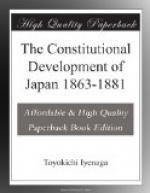But as the ancient histories were studied and the old constitution was brought into light, the real nature of the Shogunate began to reveal itself. To the eyes of the historians it became clear that the Shogunate was nothing but a military usurpation, sustained by fraud and corruption; that the Emperor, who was at that time, in plain words, imprisoned at the court of Kioto, was the real source of power and honor. “If this be the case, what ought we do?” was the natural question of these loyal subjects of the Emperor. The natural conclusion followed: the military usurper must be overthrown and the rightful ruler recognized. This was the sum and substance of the political programme of the Imperialists. The first sound of the trumpet against the Shogunate rose from the learned hall of the Prince of Mito, Komon. He, with the assistance of a host of scholars, finished his great work, the Dai Nihon Shi, or History of Japan, in 1715. It was not printed till 1851, but was copied from hand to hand by eager students, like the Bible by the medieval monks, or the works of Plato and Aristotle by the Humanists. The Dai Nihon Shi soon became a classic, and had such an influence in restoring the power of the Emperor that Mr. Ernest Satow justly calls its composer “the real author of the movement which culminated in the revolution of 1868.” The voice of the Prince of Mito was soon caught up by the more celebrated scholar Rai Sanyo (1780-1833). A poet, an historian, and a zealous patriot, Rai Sanyo was the Arndt of Japan. He outlined in his Nihon Guai Shi the rise and fall of the Minister of State and the Shoguns, and with satire, invective, and the enthusiasm of a patriot, urged the unlawfulness of the usurpation of the imperial power by these mayors of the palace. In his Sei-Ki, or political history of Japan, he traced the history of the imperial family, and mourned with characteristic pathos the decadence of the imperial power. The labors of these historians and scholars bore in time abundant fruit. Some of their disciples became men of will and action: Sakuma Shozan, Yoshida Toraziro, Gesho, Yokoi Heishiro, and later Saigo, Okubo, Kido, and hosts of others,




